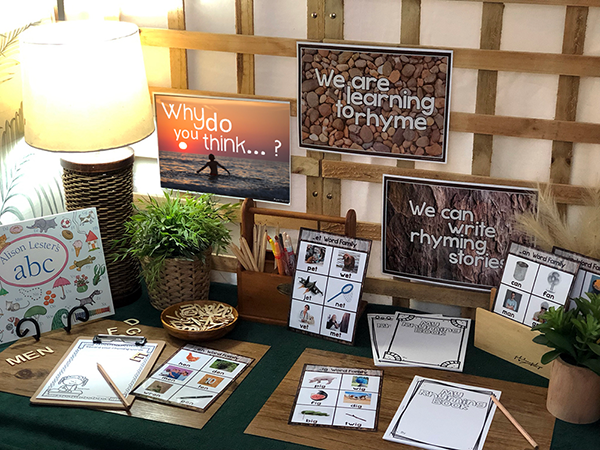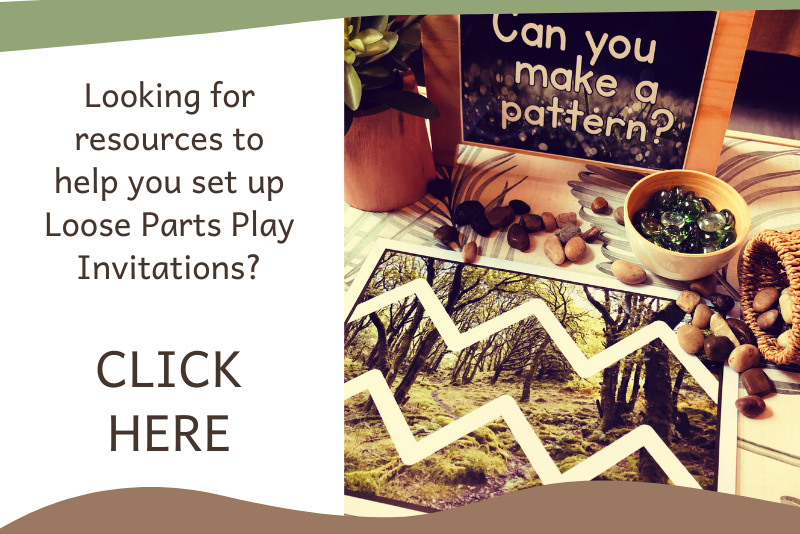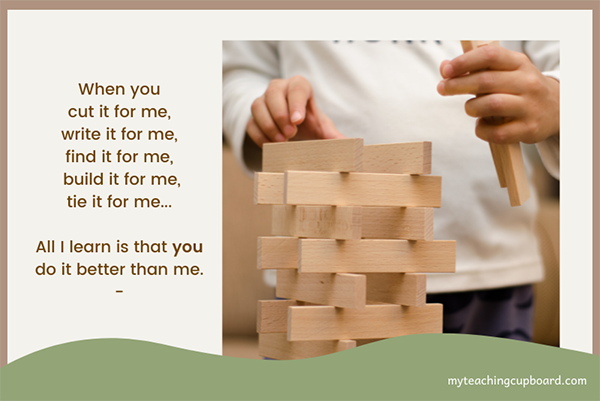The Teacher’s Role in Loose Parts Play
Loose parts are the must have resource in a play-based learning classroom. With good reason!! There are so many benefits to using loose parts in the classroom but are you wondering what is the teacher’s role in loose parts play?
In this blog post you will discover which loose parts are best for your children and find out how the teacher plays a vital role in the success of loose parts play in the classroom.
Classroom Loose Parts Materials
Your first role in loose parts play is to simply provide your children with open ended materials to use as loose parts. If you want to ensure maximum learning impact, the key is to provide loose parts which are open-ended. When you are collecting and offering loose parts, ask yourself, “Can these loose parts be used in a variety of ways and for numerous purposes?”
Because loose parts are open-ended, they will have endless possibilities unlike closed materials which can usually be used for only one purpose. If you would like a loose parts play resources list of over 150 open-ended loose parts, download this comprehensive list HERE in my Free Resources library.
Open-ended loose parts are the best type of loose parts for your classroom learning invitations.
The teacher’s role in any loose parts play invitation is more than just supplying the loose parts though.
The Teacher as an Observer of Loose Parts Play
You have sourced a selection of open-ended loose parts and set them up in an inviting learning invitation but what do you do now?
You have a crucial role in facilitating loose parts play.
Loose parts play is primarily child-led. For children to learn through their play and work at their developmental level, the teacher needs to take on the role of observer and researcher.
After observing a child working with loose parts, you will better understand that individual child’s particular developmental abilities and learning needs. You can use your observations to guide you and inform you on ways to scaffold each child’s learning.
As you observe with your teacher’s eye, you will think of new learning invitations to set up and explicit teaching lessons you might like to plan for and implement.
If you are like me, it is so easy to forget all those in the moment teaching ideas, so now I like to record my observations. Sometimes I will photograph the children’s work. After a long school day, photographs are an excellent reminder for me. Photographs are also an effective tool for documenting the learning that has happened that day.
Looking over the photos at the end of the day will not only remind me of my in the moment teaching ideas, but the photos will also act as a springboard to many other learning opportunities I can plan for.
I also use an observation checklist on a clip board to take notes during our investigation sessions. I record information about where the children were working and who they were working with etc. These notes have been invaluable at parent-teacher conferences. You can download the checklist I use HERE in the FREE Resources Library.
Scaffolding Learning in Loose Parts Play
If you provide open-ended loose parts for your children to explore and investigate, you will have many opportunities to observe and learn about your children. There will also be many opportunities for you to scaffold and extend their learning.
As your children explore the loose parts, they will demonstrate their skills and knowledge. Sometimes this can be the ideal time for you to scaffold and extend their learning.
I find it beneficial to start the conversation by asking for clarification. When you ask a child to explain what they are doing, you will be encouraging oral language, interaction and social skills AND you will be getting valuable information about that child’s thinking and understandings.
“This looks interesting. What can you tell me about it?” are open ended questions you can ask. Open ended questions are questions that can’t be answered with a simple yes or no. They require the child to respond with a clarifying explanation.
Asking open ended questions can not only give you valuable information about your learners but they will also provoke wonder and higher order thinking in your children.
If you are interested in some more open ended questions you can ask, you might be interested in these open-ended question prompts.
I often add one of these printed prompts to a loose parts learning invitation. They help encourage higher order thinking skills and enrich academic and social learning.
Taking an interest in your children’s loose parts play and asking for clarification will invite your children to verbalise their thinking and also give you insights into the next steps on their personal learning journeys.
Get Involved in Loose Parts Play
When you get involved and play alongside your children, you can model desired behaviours and skills. This can be a powerful teaching strategy. I usually wait for an invitation from the child or children before I join them and start playing too.
Sometimes children will directly ask you to explore the loose parts and join their play. Don’t wait for a verbal invitation though. Sometimes their desire to include you in their investigation might be less obvious and appear as a smile or other non-verbal cue. As you build relationships with your children and get to know them better, you will recognise their cues and respond appropriately.
If you are waiting and waiting and no invitation comes, you might just need to state your observations about their loose parts play in a nonjudgmental way. This will very often be enough to get the conversation going.
It is not your role to tell children how to play with loose parts. Observing children as they play with loose parts, it can sometimes be tempting to step in and tell children how to use the resources or even to take over and make a project for them.
Children will always learn more by doing it for themselves, even if it doesn’t work the first, second or even the third time. Making mistakes will allow children to test things and figure out what works.
Encouraging and accepting mistakes in your loose parts play is vital for developing resilience and a growth mindset. You can learn about how important this is HERE in this blog post: Affirmations & Growth Mindsets for Children
Collecting Evidence of learning in Loose Parts Play
We all have mandated curriculums and mandated assessments in our current education system. When children are playing with loose parts, there are often opportunities to collect evidence to inform your assessments and grading.
Teachers will have more success with any play based learning when they know and understand the mandated curriculum and associated assessments. If you know your curriculum and assessment pieces well, you can be on the lookout for opportunities to gather specific information or learning evidence.
This usually requires you to ask a quick closed question like, “How many candles are on your cake?” or “What sound does that start with?”
If you decide to purposely collect data during any investigative play time, there are things you need to be aware of.
Your questions may interrupt the thought processes and cognitive processing happening in your learner.
You will be demonstrating that your data collection is more important than the child’s play based learning experiences.
Primarily the teacher’s role is to observe, engage and scaffold loose parts play. I hope you enjoyed this blog post on the teacher’s role in loose parts play and you have gained some information and ideas to implement in your own classroom.
If you liked this blog post on the teacher’s role in loose parts play, please consider sharing it...
Just CLICK the sharing box below.👇














